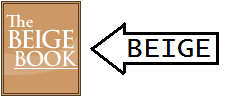The Federal Reserve has released the Beige Book
The Beige Book is a compilation of anecdotal information and data on current economic conditions across the country. The findings are NOT THE VIEWS OF FEDERAL RESERVE OFFICIALS...instead, each Federal Reserve bank interviews key business contacts, economists, market experts, and other sources in their specific district. This report is published eight times a year.
They call it the Beige Book because its Beige.

This edition was prepared at the Federal Reserve Bank of Chicago and is based on information collected on or before May 28, 2010.
Below is a summary of the findings and a few excerpts on bank lending and housing...
Summary
Economic activity continued to improve since the last report across all twelve Federal Reserve Districts, although many Districts described the pace of growth as "modest."
Consumer spending and tourism activity generally increased. Business spending also rose, on net, with employment and capital spending edging up but inventory investment slowing. By sector, nonfinancial services, manufacturing, and transportation continued to gradually improve.
Residential real estate activity in many Districts was buoyed by the April deadline for the homebuyer tax credit. Commercial real estate remained weak, although some Districts reported an increase in leasing.
Financial activity was little changed on balance, although a few Districts noted a modest increase in lending. Spring planting was generally ahead of the normal pace, while conditions in the natural resource sectors varied across the Districts. Prices of final goods and services were largely stable as higher input costs were not being passed along to customers and wage pressures continued to be minimal.
Real Estate and Construction
Residential real estate activity improved since the last report. Most Districts noted an increase in home sales and construction prior to the April 30th deadline for the homebuyer tax credit, with contacts in many of these Districts also indicating a corresponding slowing in activity in May.
Tight credit, the elevated inventory of homes available for sale, and the "shadow inventory" of foreclosed properties on banks' balance sheets held back residential development in the New York, Cleveland, Atlanta, and Chicago Districts.
Commercial real estate activity generally remained weak. Office, industrial, and retail vacancy rates continued to drift upward in many Districts putting downward pressure on rents. However, lower rents were said to have led to an increase in leasing activity in New York, Philadelphia, Richmond, Kansas City, Dallas, and San Francisco. The elevated inventory of existing properties for sale or rent continued to weigh on new private nonresidential construction. However, stronger industrial demand was noted in several Districts. Public construction increased in Philadelphia, Cleveland, and Chicago, but slowed in Minneapolis.
Banking and Finance
Financial activity was little changed on balance from the previous report. Commercial and industrial lending by banks remained weak in most Districts, although Philadelphia, Chicago, Dallas, and San Francisco noted business loan demand was firming. Philadelphia also indicated an increase in business lending by non-depository financial companies, and New York reported that underwriting and investment banking activity strengthened.
Consumer lending weakened in most Districts. In contrast, real estate lending increased even though standards on these loans remained tighter than on other loans, particularly for commercial mortgages. Chicago noted that the secondary market for residential mortgages was beginning to improve, and private equity investment in commercial properties increased in Boston, Chicago, and Dallas.
Loan quality was indicated to be stabilizing or gradually improving in most Districts, but remained an issue for banks with large exposures to real estate. Contacts in some Districts cited concerns over the potential impact of the European fiscal crisis on financial and business conditions, and reported a corresponding increase in uncertainty and financial market volatility.







